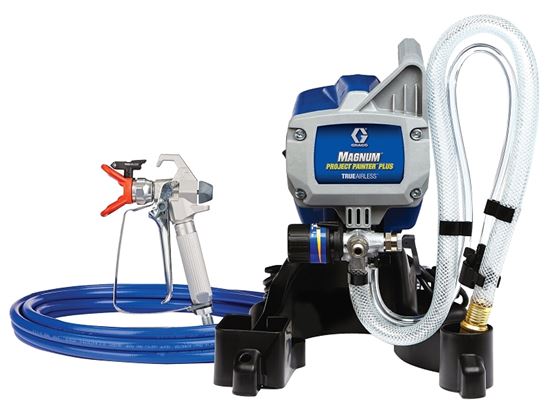Painting projects can be daunting, but with the right tools, they become much more manageable. If you’re aiming for a flawless finish that rivals professional work, a sprayer can be your secret weapon. Whether you’re tackling a large wall, detailed furniture, or even an outdoor fence, a paint sprayer offers precision, speed, and a smooth, even coat that’s hard to achieve with brushes and rollers. In this guide, we’ll explore how to achieve professional results with a sprayer and make your painting projects easier and more efficient.
Why Choose a Sprayer?
Superior Finish
The most significant advantage of using a sprayer is the superior finish it provides. Unlike brushes and rollers, which can leave behind streaks, marks, or uneven textures, a sprayer delivers a fine mist of paint that coats surfaces evenly. This results in a smooth, flawless finish that looks professionally done. Whether you’re working on walls, cabinets, or furniture, a sprayer ensures that your paint job looks impeccable.
Efficiency and Speed
One of the biggest challenges of painting is the time it takes to complete the job. A sprayer can drastically reduce the time required by covering large areas quickly and efficiently. This is particularly useful for projects that involve extensive surfaces, such as painting an entire room, ceiling, or exterior walls. With a sprayer, you can complete your project in a fraction of the time it would take with traditional methods, leaving you more time to enjoy your newly painted space.
Versatility
Sprayers are incredibly versatile and can be used for a wide range of projects. From walls and ceilings to furniture and fences, a sprayer can handle various surfaces and materials. Many sprayers come with adjustable settings, allowing you to customize the spray pattern, pressure, and flow to suit your specific project. This versatility makes a sprayer an essential tool for any DIY enthusiast or homeowner looking to achieve professional results.
Choosing the Right Sprayer
Types of Sprayers
When selecting a sprayer, it’s important to choose the right type for your project. There are three main types of sprayers to consider: airless, HVLP (High Volume Low Pressure), and compressed air sprayers.
- Airless Sprayers: These are powerful and efficient, making them ideal for large projects like walls, ceilings, and exterior surfaces. They work by pumping paint at high pressure, creating a fine mist that coats surfaces evenly. Airless sprayers are best for thick paints and large areas.
- HVLP Sprayers: HVLP sprayers use a high volume of air at low pressure to atomize the paint, resulting in a finer, more controlled spray. These sprayers are perfect for detailed work, such as furniture, cabinets, and trim. They are also more efficient in terms of paint usage, with less overspray.
- Compressed Air Sprayers: These sprayers use compressed air to push paint through a nozzle, creating a smooth, even coat. They are less common for home use but can be effective for small projects and detailed finishes.
Considerations for Choosing a Sprayer
When selecting a sprayer, consider the following factors:
- Project Size: For large projects like walls and ceilings, an airless sprayer is ideal. For smaller, more detailed work, an HVLP or compressed air sprayer may be more suitable.
- Ease of Use: Look for a sprayer that is user-friendly, with easy setup, operation, and cleanup. Features like adjustable settings, lightweight design, and quick-connect hoses can make a big difference.
- Budget: Sprayers come in a wide range of prices, so choose one that fits your budget while still meeting your needs. More expensive models often offer better performance and additional features, but there are also affordable options that can deliver excellent results.
How do prepare a surface for spraying?
Proper surface preparation is key to a smooth finish:
- Clean the Surface: Remove dust, dirt, and grease. Use a cleaner or degreaser if needed.
- Repair Imperfections: Fill any holes, cracks, or dents with appropriate filler or patching material.
- Sand the Surface: For a smooth application, sand the surface to remove old paint and create a key for the new coat.
- Prime if Necessary: Apply a primer to enhance adhesion and coverage, especially on new or bare surfaces.
How can I avoid common spraying problems like streaks or overspray?
To achieve a professional finish and minimize issues:
- Maintain a Consistent Distance: Hold the sprayer at a consistent distance (usually 6-12 inches) from the surface to ensure even coverage.
- Keep a Steady Hand: Move the sprayer in smooth, even strokes to avoid streaks and uneven areas.
- Use Proper Technique: Overlap each pass slightly and maintain a steady speed to avoid gaps and streaks.
- Test the Sprayer: Before starting your project, do a test spray on a piece of scrap material to adjust settings and practice your technique.
Conclusion
In conclusion, using a graco homeowner sprayer parts can help you achieve professional-quality results on your painting projects with less effort and time. Whether you’re painting a room, refinishing furniture, or tackling an outdoor project, a sprayer offers the precision, speed, and versatility needed to get the job done right.
By choosing the right sprayer for your needs, practicing proper technique, and maintaining your equipment, you can transform your home with ease and confidence. Embrace the power of a sprayer and take your DIY projects to the next level.







